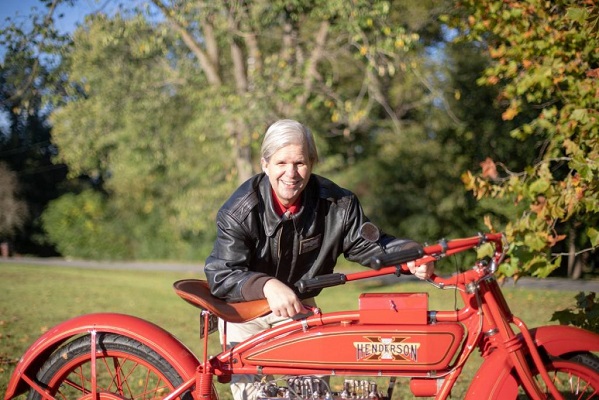In 1919, British Royal Air Force Captain Charles Kenilworth “C.K.” Shephard explored miles of territory on his trip across America on a 1919 Henderson motorcycle without the aid of GPS or knowledge of American roadways. This summer, nearly 100 Years later United States Air Force Captain Mark Leslie Hunnibell retraces C.K.’s exact path with an epic journey from New York City to San Francisco covering nearly 4,500 miles across America on his own vintage four-speed 1919 Henderson motorcycle. Not only is Across America by Motor-Cycleby Captain Mark Hunnibellone of the most exciting adventure motorcycle books written, but it contains fascinating facts and history about America during the beginning of the 1900s.
Buy the Book:
Follow Captain Hunnibell’s Journey:
https://acrossamericabymotorcycle.com/A big thanks to Captain Mark L. Hunnibellfor talking with me today about his upcoming book and tour across America …
What is your book, Across America by Motor-Cycle about?
The 1922 book, Across America by Motor-Cycle, is the story told by Captain C.K. Shepherd, a Royal Air Force (RAF) veteran of WWI from England who crossed America by motorcycle in 1919 after the war. In mid-June, within two weeks of arriving in Manhattan, C.K. bought a top-of-the-line Henderson four-cylinder motorcycle and was hot on the trail for California. In 1922, C.K.’s book was published, the story of his transcontinental journey in the summer of 1919 through sixteen states covering nearly 5,000 miles. C.K.’s story documents an amazing journey but regretfully did not include many details of the trip and the man who took it. This book answers them all.
What do you hope readers will get from reading the annotated version of the book as opposed to C.K. Shepherd’s original book?
First, C.K.’s original book is embedded within mine (or rather my notes are embedded within his). So the reader can read the original text as it was written and observe a note number on a point of interest, flip a few pages to the end of the chapter to read the note, and the come back to continue reading.Second, I discovered many (surely unintentional) discrepancies with the book such as distances travelled, names of people and cities, etc.. Where I found such issues, I have noted them and drawn conclusions as to the nature of the problem and apparent solution. I felt like a bit of a “fact checker” when doing this work, but I was on a quest to be as accurate and thorough as possible.
Your book has a forward by Dr. Charles Drury Shaw, the son of Captain C.K. Shepherd. How did that come about?
I recently posted a rather lengthy blog entry to my web site addressing this. The short version is that I discovered that, in 1948, Charles Kenilworth Shepherd legally changed his name to Charles Kay Shaw. In 2017, I obtained a copy of his death certificate from 1971 identifying his son, Charles Drury Shaw, as the “reporting individual.” I was unsuccessful finding Charles Drury Shaw until I found the will of C.K.’s second wife, who named Charles Drury Shaw’s two children as contingent beneficiaries. I successfully located and contacted one of those two grandchildren (C.K.’s grandson) who informed me that his father was still alive and would know much more about C.K.’s life and times, after whichDr. Shaw and I have been in nearly constant contact ever since.
Is the Shepherd family proud of your interest in their ancestor’s journey in America?
My only real hope in contacting C.K.’s descendants was that they would pardon my intrusion in my quest to see additional background, documentation, etc., about the book. Never did I imagine how touched his son would be that I had reached out and found him. Every time I read the first sentence of the foreword that Charles Drury Shaw wrote for my book, tears of pride begin to well up in me, “My father had been dead for 46 years when Mark Hunnibell brought him back to me.”So yes, I think they are proud.
Your annotated book is loaded with photos. Are these from C.K. Shepherd’s original book’s photos or are they new? Why did you add more?
There are about 250 new photos, figures, and illustrations. Thirty-eight of the photos were scanned from “magic lantern” slides that C.K. had preserved and used in presentations about his travels (this trip was only one of many in his life). A few of those thirty-eight photos were higher resolution images from the ones in the 1922 book, so I used the better resolution in my book rather than scans from the original. Additionally, I felt that many details C.K. described deserved illustration, so I searched period publications to find examples of what C.K. would have actually seen or been describing. Those photos came from various other sources.
Your book is quite large at 451 pages. What tools did you use to research C.K.’s journey in order to guide the reader to all the facts you present? How long did it take you to research and annotate this book?
I used a wide variety of online and brick-and-mortar search tools. I visited libraries and called librarians. Searched newspapers here and abroad. I wrote to people. I called them. One of the biggest breakthroughs occurred in May 2017 when I made a “cold call” by phone that quickly led to a meeting with the grandsons of “Steve” whom C.K. served with in WWI and visited later in Cincinnati. They gave me copies of four wonderfully informative letters between C.K. and “Steve.” These letters (three from C.K., one from “Steve”) were almost evenly spread out in time over four decades beginning in 1928. In all, I spent at least five years in part time research. The number of hours I spent is countless, but I’m confident that it numbers in the thousands.





